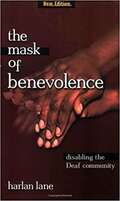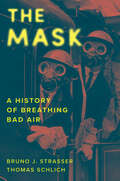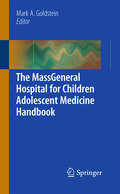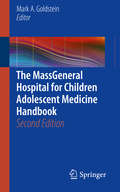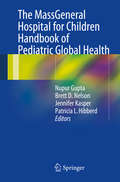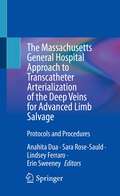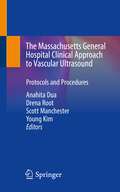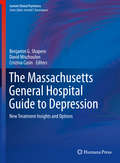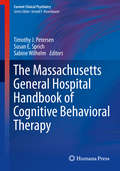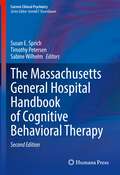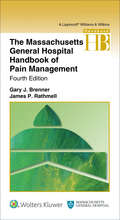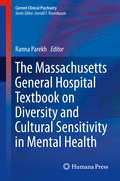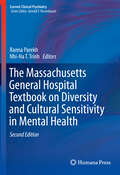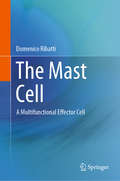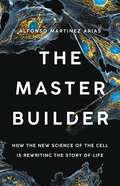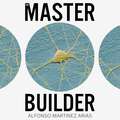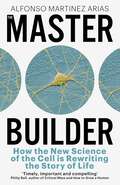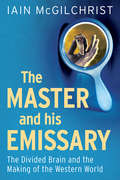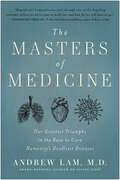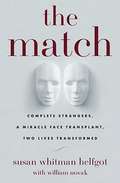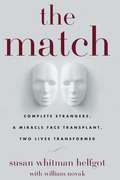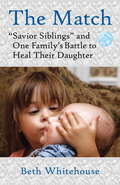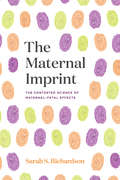- Table View
- List View
The Mask of Benevolence: Disabling the Deaf Community
by Harlan LaneA look at the gulf that separates the deaf minority from the hearing world, this book sheds light on the mistreatment of the deaf community by a hearing establishment that resists understanding and awareness. Critically acclaimed as a breakthrough when it was first published in 1992, this new edition includes information on the science and ethics of childhood cochlear implants. An indictment of the ways in which experts in the scientific, medical, and educational establishment purport to serve the deaf, this book describes how they, in fact, do them great harm.
The Mask: A History of Breathing Bad Air
by Thomas Schlich Bruno J. StrasserA history of masks protecting against bad air—in cities, factories, hospitals, and war trenches—exploring how our identities and beliefs shape the decision to wear a mask For centuries, humans have sought to protect themselves from harmful air, whether from smoke, dust, vapors, or germs. This book offers the first history of respiratory masks—ranging from simple pieces of cloth to elaborate gas masks—and explores why they have sparked both hope and fear. Bruno J. Strasser and Thomas Schlich captivate readers with stories of individuals—from renowned doctors and political leaders to forgotten inventors and anonymous factory workers—who passionately debated the value of masks. In Renaissance Italy and Meiji Japan, in Victorian Britain and Cold War America, the way societies have engaged with face coverings reveals their deepest cultural and political fractures. The Mask challenges us to reconsider how we care for one another and the kind of environment we aspire to inhabit.
The MassGeneral Hospital for Children Adolescent Medicine Handbook
by Mark A. GoldsteinThe MassGeneral Hospital for Children Adolescent Medicine Handbook, is a definitive, practical guide for the optimal clinical care of adolescents. This unique and invaluable resource is not only replete with user-friendly diagrams, tables, charts and pathways; it most importantly covers in detail the best practices in adolescent medicine where practice not only means the most appropriate approaches, diagnostic evaluation and best treatments, but also the best ways to connect, communicate and continue care with teenagers. Divided into three sections, the handbook covers general adolescent medicine, sexuality, and mental health. Chapters are written by outstanding physician authors who represent expertise in pediatric or adult specialties and have taught or trained at Massachusetts General Hospital. The MassGeneral Hospital for Children Adolescent Medicine Handbook joins together the collective knowledge and wisdom of its esteemed contributors to provide a multi-specialty approach to adolescent healthcare that balances the science and the art of adolescent medicine.
The MassGeneral Hospital for Children Adolescent Medicine Handbook
by Mark A. GoldsteinThe second edition of this definitive guide for clinical care of adolescents builds upon the practical knowledge and guidance of the first edition, and expands into new subjects of adolescent care. The handbook is divided into three sections: general adolescent medicine, sexuality, and mental health, and contains relevant, practical knowledge, covering those areas most often seen in the practice of adolescent medicine. The MassGeneral Hospital for Children Adolescent Medicine Handbook, 2nd edition details best practices in regards to diagnostic evaluations and clinical care, but also instructs practitioners on the best methods to connect, communicate, and continue that care with adolescents, in order to provide optimal treatment, and instill healthy lifetime behaviors. Each chapter is written by clinicians who have been trained at, or are members of the staff of Massachusetts General Hospital, and this edition has nearly doubled the amount of skilled physician authors. While this title has been revised and updated, entirely new chapters devoted to hypertension, immunizations, breast disorders, HIV, and resilience have also been added, reflecting new and changing contributions to the field of adolescent medicine. This second edition brings together the practical, hands-on knowledge of the first edition, along with new information and additional subject areas to create a balanced, multi-specialty method to treating and engaging adolescent patients.
The MassGeneral Hospital for Children Handbook of Pediatric Global Health
by Brett D. Nelson Nupur Gupta Jennifer Kasper Patricia L. HibberdThe MassGeneral Hospital for Children Handbook of Pediatric Global Health is a concise resource for the ever-increasing number of health professionals involved in global health, many of whom spend a few weeks to months or even years providing medical care in resource-poor countries. This Handbook provides practical, evidence-based, hands-on guidance for managing and preventing childhood illnesses when resources are limited in low- and middle-income countries. It also offers a setting-specific understanding and management approaches to the major causes of childhood mortality, including pneumonia, diarrhea, birth asphyxia, complications of preterm birth, and neonatal sepsis. The Handbook provides an overview of childhood mortality, health systems, and the various stakeholders that play a role in the global health arena, and also contains chapters focusing on adolescents who are increasingly recognized as a unique population in whom interventions can go a long way in bothconsolidating the gains made in childhood and preventing adult disease. Finally, key topics in non-communicable diseases are covered, including trauma and injuries, pediatric mental health, child and adolescent rights, and oral health. Not meant solely for pediatricians, the Handbook is designed for generalists, specialists, doctors, nurses, other health care workers, and those in training. An indispensable reference for health professionals overseas, the Handbook will also be a useful addition and resource for academic centers and universities in industrialized nations that are creating courses for trainees who will do clinical electives abroad during their training.
The Massachusetts General Hospital Approach to Transcatheter Arterialization of the Deep Veins for Advanced Limb Salvage: Protocols and Procedures
by Anahita Dua Sara Rose-Sauld Lindsey Ferraro Erin SweeneyThis book presents an in-depth guide to transcatheter arterialization of the deep veins (TADV). TADV or deep venous arterialization (DVA) is an emerging technological and clinical solution for patients with peripheral artery disease who have no options for limb salvage based on conventional vascular techniques. It serves to salvage limbs in patients who would otherwise be amputated. For TADV to be successful in preventing amputation patient selection, pre-procedure imaging, technical expertise, and post-operative wound management must be optimized. The book takes a step-by-step approach to TADV to guide the clinical team through the patient journey from meeting a potential candidate for TADV through to saving the leg. Chapters provide a reference for patient selection, procedural steps, and post-operative wound care management. This is an ideal guide for vascular surgeons, interventional radiologists, interventional cardiologists, trainees, and all medical professionals caring for patients with severe peripheral artery disease potentially facing amputation.
The Massachusetts General Hospital Clinical Approach to Vascular Ultrasound: Protocols and Procedures
by Anahita Dua Young Kim Scott Manchester Drena RootThis book is designed to provide easy to reference, up to date protocols and procedures for vascular ultrasound. The text also delineates how to interpret imaging findings and implement results for optimal patient care outcomes. Chapters thoroughly cover an array of topics focused on the interpretation of vascular ultrasound, including transcranial Doppler, hemodialysis fistula mapping, and pelvic venous duplex, as well as the protocols and standards of the Massachusetts General Hospital Vascular Lab. Expert authors provide step by step detail on how to perform vascular lab examinations correctly, how to clinically interpret results, and how to implement findings into clinical practice. There is additionally coverage of how to develop and receive accreditation for a new vascular laboratory. This is an ideal guide for vascular surgeons, general surgeons, primary care physicians, vascular technologists, interventional radiologists, cardiologists, vascular medicine specialists, anesthesiologist and any practitioners who practice vascular ultrasound.
The Massachusetts General Hospital Guide to Depression: New Treatment Insights and Options (Current Clinical Psychiatry)
by Benjamin G. Shapero David Mischoulon Cristina CusinMajor Depressive Disorder (MDD) is one of the most prevalent psychiatric disorders, with a lifetime prevalence rate of roughly 20%. MDD is a leading cause of disability and premature death worldwide, leads to greater impairment in work functioning than other chronic medical conditions, and has an estimated annual cost of $210 billion in the US. The proposed text is designed for mental health professionals and will present state-of-the-art treatment options that are used in the Depression Clinical and Research Program (DCRP) at the Massachusetts General Hospital. The text provides different treatment options so that providers can ‘think outside the box’ of conventional interventions. The introductory sections discuss general themes about diagnosing and treating depression. The major body of the book, however, consists of chapters organized under the topics of new medication, new psychotherapy, alternative treatments, and consideration of specific populations and how to modify interventions to best treat these patients. Each chapter begins with a case vignette to illustrate key characteristics of the disorder process or treatment and reviews the history, research support, and new advances of these topics. In addition, the chapters include a description of how to apply this topic in treatment and frequently asked questions and answers. This book will be a unique contribution to the field. Existing guides focus on individual treatments of Depression, or include brief descriptions of interventions as a whole. The DCRP has consistently been a forerunner of clinical treatments for depression and often treats challenging cases of this disorder. This book will provide a practical and useful resource with wide applicability.
The Massachusetts General Hospital Handbook of Cognitive Behavioral Therapy
by Sabine Wilhelm Timothy J. Petersen Susan E. SprichCognitive Behavioral Therapy (CBT) has a growing evidence base that supports its efficacy in treating a wide range of psychiatric disorders and has been adapted for use with more complicated patient populations and for different stages of psychiatric illness. As the first Massachusetts General Hospital-branded text on the subject, this is a cutting-edge tool that is unlike any current book on CBT. The authors for this handbook are among the world's foremost experts in their specialty area and are actively engaged in dynamic research evaluating the efficacy of CBT as well as identifying mechanisms of action for this treatment. This title provides in-depth coverage of the historical background of the development of CBT, a comprehensive review of relevant outcomes data, a survey of mechanisms by which CBT exerts its effect, and, most importantly, a take away "tool box" of CBT strategies and techniques that can be immediately implemented in clinicians' practices. The Massachussetts General Hospital Handbook of Cognitive Behavioral Therapy reaches and improves the clinical practices of a broad base of front line mental health practitioners, including psychiatrists and therapists.
The Massachusetts General Hospital Handbook of Cognitive Behavioral Therapy (Current Clinical Psychiatry)
by Sabine Wilhelm Susan E. Sprich Timothy PetersenThis book provides a fully updated in-depth overview of Cognitive Behavioral Therapy (CBT), which is the most widely-disseminated evidence-based psychotherapy utilized today.The Massachusetts General Hospital Handbook of Cognitive Behavioral Therapy, 2nd edition displays the constantly evolving nature of CBT due to the continuous research trials conducted by clinicians. This second edition presents updated information and literature to reflect the current clinical guidelines based on research studies that have been published in the past few years. Chapters cover applying CBT to common disorders such as depression, obsessive-compulsive disorder, and anxiety disorders, as well as more specialized applications such as schizophrenia. Chapters also provide information on how to tailor CBT for specific populations and in specific settings. The book also features new chapters on the use of technology in treating psychiatric disorders and novel models of care and treatments for psychiatric disorders. The fully updated and expanded second edition of The Massachusetts General Hospital Handbook of Cognitive Behavioral Therapy will continue to be a go-to resource for all psychiatrists, psychologists, social workers, licensed mental health counselors, primary care doctors, graduate students, and psychiatry residents and fellows implementing cognitive behavioral therapy in their clinical practice.
The Massachusetts General Hospital Handbook of Pain Management
by Gary Brenner James RathmellOffering expert guidance from seasoned clinicians at Massachusetts General Hospital, this bestselling handbook provides accurate, clinically essential information in a portable, quick-reference format. Broad-based, multidisciplinary coverage draws from the disciplines of anesthesiology, neurology, behavioral medicine, nursing, psychiatry, and physical therapy to provide practical, evidence-based information for sound therapeutic choices. Now in full color for the first time, The Massachusetts General Hospital Handbook of Pain Management, Fourth Edition, contains numerous new chapters, new illustrations, and other features that keep you up to date with today’s latest approaches to pain management.
The Massachusetts General Hospital Textbook on Diversity and Cultural Sensitivity in Mental Health
by Ranna ParekhLong considered important for professionals working with minority and under-represented populations, cross-cultural competency has become a requisite for all health care providers. As society in the US increasingly diversifies, there is a crucial need to prepare health care professionals to effectively treat this changing population. The Massachusetts General Hospital Textbook on Diversity and Cultural Sensitivity in Mental Health addresses the importance and relevance of cultural sensitivity in US mental health. Prominent researchers and clinicians examine the cultural and cross-cultural mental health issues of Native American, Latino, Asian, African American, Middle Eastern, Refugee and LGBQT communities. The discussion includes understanding the complexities in making mental health diagnoses and the various meanings it has for the socio-cultural group described, as well as biopsychosocial treatment options and challenges. In understanding the specific populations, the analysis delves into overarching concepts that may apply to specific populations and to those at the intersection of multiple cultures. An invaluable resource for mental health professionals, including clinicians, researchers, educators, leaders and advocates in the United States, The Massachusetts General Hospital Textbook on Diversity and Cultural Sensitivity in Mental Health provides the necessary understanding and insights for research and clinical practice in specific cultural and multicultural groups.
The Massachusetts General Hospital Textbook on Diversity and Cultural Sensitivity in Mental Health (Current Clinical Psychiatry)
by Ranna Parekh Nhi-Ha T. TrinhThis edition is updated to include new research and clinical material for practitioners working with mental health patients of diverse backgrounds. Written by experts in cultural sensitivity, the text begins by establishing innovative approaches to understanding diversity, tools for diversity educational training for health care providers, clinical interviewing techniques and effective strategies in having difficult conversations. Indirect approaches to understanding diversity and mental health come from unique chapters that range from the ways that journalists process and discuss mental health competency to the business model for cultural competency in health care.The second section of the book moves from the broader subjects to the needs of specific populations, including Native Americans, Latinos, Asians, African American, Middle Eastern, Refugee and LGBQT communities. The discussion includes understanding the complexities of making mental health diagnoses and the various meanings these diagnoses have for the socio-cultural group described. Each chapter also details biopsychosocial treatment options and challenges.The Massachusetts General Hospital Textbook on Diversity and Cultural Sensitivity in Mental Health, Second Edition, is an excellent resource for all clinicians working with diverse populations, including psychiatrists, primary care physicians, emergency room physicians, early career physicians and trainees, psychologists, nurses, social workers, researchers, and medical educators.
The Mast Cell: A Multifunctional Effector Cell
by Domenico RibattiMast cells (MC) are phylogenetically old cells which are distributed throughout the human organism. MC are found in almost all of the major organs and tissues of the body, particularly in association with connective tissue structures such as blood vessels, lymphatic vessels and nerves, and in proximity to surfaces that interface the external environment, such as those of the respiratory and gastrointestinal system and the skin. This selective accumulation at tissue sites where foreign material attempts to invade the host suggests that MC are among the first cells to initiate defensive mechanisms. MC have long been recognized as key cells of type I hypersensitivity reactions. Several lines of evidence, however, indicate that they not only express critical effector functions in classic IgE-associated allergic disorders, but also play important roles in host defense against parasites, bacteria and perhaps even viruses. Indeed, it is now clear that MC can contribute to host defense in the context of either acquired or innate immune responses through the release of a myriad of pro-inflammatory and immunoregulatory molecules and the expression of a wide spectrum of surface receptors for cytokines and chemokines. Moreover, there is growing evidence that MC exert distinct non-immunological functions, playing a relevant role in tissue homeostasis, remodeling and fibrosis as well as in the processes of tissue angiogenesis.
The Master Builder: How the New Science of the Cell Is Rewriting the Story of Life
by Dr. Alfonso Martinez Arias"An ingenious argument" (Kirkus) for a "novel thesis" (Publishers Weekly) that cells, not DNA, hold the key to understanding life&’s past and present What defines who we are? For decades, the answer has seemed obvious: our genes, the &“blueprint of life.&” In The Master Builder, biologist Alfonso Martinez Arias argues we&’ve been missing the bigger picture. It&’s not our genes that define who we are, but our cells. While genes are important, nothing in our DNA explains why the heart is on the left side of the body, how many fingers we have, or even how our cells manage to reproduce. Drawing on new research from his own lab and others, Martinez Arias reveals that we are composed of a thrillingly intricate, constantly moving symphony of cells. Both their long lineage—stretching back to the very first cell—and their intricate interactions within our bodies today make us who we are. Engaging and ambitious, The Master Builder will transform your understanding of our past, present, and future—as individuals and as a species.
The Master Builder: How the New Science of the Cell is Rewriting the Story of Life
by Alfonso Martinez AriasA leading developmental biologist argues that cells, not DNA, hold the key to understanding history, present, and future of life.What defines who we are? For decades, the biological answer has been our genes. In The Master Builder, leading biologist Alfonso Martinez Arias breaks with decades of scientific and popular tradition to make a bold argument: what defines us is our cells. Drawing on new research from his lab and others, Martinez Arias reveals that we are composed of a thrillingly complex, constantly rearranging symphony of cells that know how to count, feel, and ultimately give form to our bodies. While DNA is important, Richard Dawkins's vision of the selfish gene that controls everything is not a good description of how biology actually works. As Martinez Arias shows, nothing in your genes explains why your heart is on the left side of your body, why you have five fingers and not ten, or why genetically identical twins have different sets of fingerprints and why it's possible for a mother to apparently share no DNA with the children to whom she gave birth! At the heart of it all is not simply gee-whiz science, but a powerful new conception of the essence of life.Our identities are shaped not simply by our genes, but by the interconnections between all our cells, working as a sort of symphony-cooperative, and creating something greater than its parts could on their own-and the unbroken lineage of cells that connects us to the first fertilized egg from which we developed-and in turn, back through the billions of years of our planet's history, to the very first cell in the history of all life on Earth.A sweeping revision of both the present and history of life, The Master Builder puts forward a new paradigm for understanding biology, one rooted in cellular cooperation, not selfish genes. Engaging and ambitious, it will transform our understanding of where we come from, what shapes us, and where we are going, as individuals, a species, and the community of life itself.(P)2023 Hodder & Stoughton Limited
The Master Builder: How the New Science of the Cell is Rewriting the Story of Life
by Alfonso Martinez AriasWhat defines who we are? Until now, the biological answer has been our genes. Leading biologist Alfonso Martinez Arias breaks with popular tradition to make a bold argument: what defines us is our cells. Drawing on groundbreaking research, he reveals that we are composed of a thrillingly complex, constantly rearranging symphony of cells that know how to count, feel, and give form to our bodies. While DNA is important, nothing in your genes explains why your heart is on the left, why you have five fingers and not ten, why genetically identical twins have different sets of fingerprints, or why it's possible for a mother to apparently share no DNA with the children she gave birth to! At the heart of it all is a powerful new conception of the essence of life. Our identities are shaped by the interconnections between cells, working cooperatively, creating something greater than its parts - the unbroken lineage that connects us to the fertilized egg from which we developed and back through the billions of years of our planet's history, to the very first cell of all life on Earth. A sweeping revision of both the present and the history of life, The Master Builder puts forward a new paradigm for understanding biology, transforming our approach to where we come from, what shapes us, and where we are going - as individuals, a species, and the community of life itself.
The Master and His Emissary
by Iain McgilchristWhy is the brain divided? The difference between right and left hemispheres has been puzzled over for centuries. In a book of unprecedented scope, Iain McGilchrist draws on a vast body of recent brain research, illustrated with case histories, to reveal that the difference is profound--not just this or that function, but two whole, coherent, but incompatible ways of experiencing the world. The left hemisphere is detail oriented, prefers mechanisms to living things, and is inclined to self-interest, where the right hemisphere has greater breadth, flexibility, and generosity. This division helps explain the origins of music and language, and casts new light on the history of philosophy, as well as on some mental illnesses.In the second part of the book, McGilchrist takes the reader on a journey through the history of Western culture, illustrating the tension between these two worlds as revealed in the thought and belief of thinkers and artists, from Aeschylus to Magritte. He argues that, despite its inferior grasp of reality, the left hemisphere is increasingly taking precedence in the modern world, with potentially disastrous consequences. This is truly a tour de force that should excite interest in a wide readership.
The Masters of Medicine: Our Greatest Triumphs in the Race to Cure Humanity's Deadliest Diseases
by Andrew LamAn in-depth look at the mavericks, moments, and mistakes that sparked the greatest medical discoveries in modern times—plus the cures that will help us live longer and healthier lives in this century . . . and beyond. Human history hinges on the battle to confront our most dangerous enemies—the half-dozen diseases responsible for killing almost all of mankind. And while the story of our triumphs over these afflictions reveals an inspiring tapestry of human achievement, the journey was far from smooth. In The Masters of Medicine, Dr. Andrew Lam distills the long arc of medical progress down to the crucial moments that were responsible for the world&’s greatest medical miracles. Discover fascinating true stories of scientists and doctors throughout history, including: Rival surgeons who killed patient after patient in their race to operate on beating hearts—and put us on the path toward the heart transplant A quartet of Canadians whose miraculous discovery of insulin was marred by jealousy and resentment The doctors who discovered penicillin, but were robbed of the credit The feud between two Americans in the quest for the polio vaccine A New York surgeon whose &“heretical&” idea to cure patients by deliberately infecting them has now inspired our next-best hope to defeat cancer A Hungarian doctor who solved the greatest mystery of maternal deaths in childbirth, only to be ostracized for his discovery The Masters of Medicine is a fascinating chronicle of human courage, audacity, error, and luck. This riveting ode to mankind reveals why the past is prelude to the game-changing breakthroughs of tomorrow.
The Match
by Susan Whitman HelfgotJoseph Helfgot, the son of Holocaust survivors, worked his way from a Lower East Side tenement to create a successful Hollywood research company. But his heart was failing. After months of waiting for a heart transplant, he died during the operation. Hours after his death, his wife Susan was asked a shocking question: would she donate her husband’s face to a total stranger?The stranger was James Maki, the adopted son of parents who spent part of World War II in an internment camp for Japanese Americans. Rebelling against his stern father, a professor, by enlisting to serve in Vietnam, he returned home a broken man, addicted to drugs. One night he fell facedown onto the electrified third rail of a Boston subway track. A young Czech surgeon who was determined to make a better life on the other side of the Iron Curtain was on call when the ambulance brought Maki to the hospital. Although Dr. Bohdan Pomahac gave him little chance of survival, Maki battled back. He was sober and grateful for a second chance, but he became a recluse, a man without a face. His only hope was a controversial face transplant, and Dr. Pomahac made it happen. InThe Match,Susan Whitman Helfgot captures decades of drama and history, taking us from Warsaw to Japan, from New York to Hollywood. Through wars and immigration, poverty and persecution, from a medieval cadaver dissection to a stunning seventeen-hour face transplant, she weaves together the story of people forever intertwined—a triumphant legacy of hope.
The Match
by William Novak Susan Whitman HelfgotJoseph Helfgot, the son of Holocaust survivors, worked his way from a Lower East Side tenement to create a successful Hollywood research company. But his heart was failing. After months of waiting for a heart transplant, he died during the operation. Hours after his death, his wife Susan was asked a shocking question: would she donate her husband's face to a total stranger? The stranger was James Maki, the adopted son of parents who spent part of World War II in an internment camp for Japanese Americans. Rebelling against his stern father, a professor, by enlisting to serve in Vietnam, he returned home a broken man, addicted to drugs. One night he fell facedown onto the electrified third rail of a Boston subway track. A young Czech surgeon who was determined to make a better life on the other side of the Iron Curtain was on call when the ambulance brought Maki to the hospital. Although Dr. Bohdan Pomahac gave him little chance of survival, Maki battled back. He was sober and grateful for a second chance, but he became a recluse, a man without a face. His only hope was a controversial face transplant, and Dr. Pomahac made it happen. In The Match, Susan Whitman Helfgot captures decades of drama and history, taking us from Warsaw to Japan, from New York to Hollywood. Through wars and immigration, poverty and persecution, from a medieval cadaver dissection to a stunning seventeen-hour face transplant, she weaves together the story of people forever intertwined--a triumphant legacy of hope.
The Match: Savior Siblings and One Family's Battle to Heal Their Daughter
by Beth WhitehouseMy Sister's Keeper in nonfiction: a family's real-life struggle to cure their daughter by creating her genetic match Katie Trebing was diagnosed at three months old with Diamond Blackfan anemia, a rare form of anemia that prevents bone marrow from producing red blood cells. Even with a lifetime of monthly blood transfusions, she faced a poor prognosis. Pulitzer Prize-winning journalist Beth Whitehouse follows the Trebings as they make the decision to create a genetically matched sibling using preimplantation genetic diagnosis (PGD) and in vitro fertilization, and proceed with a risky bone-marrow transplant that could kill their daughter rather than save her. The Match is a timely and provocative look at urgent issues that can only become more complex and pressing as genetic and reproductive technologies advance.From the Trade Paperback edition.
The Maternal Imprint: The Contested Science of Maternal-Fetal Effects
by Sarah S. RichardsonLeading gender and science scholar Sarah S. Richardson charts the untold history of the idea that a woman's health and behavior during pregnancy can have long-term effects on her descendants' health and welfare. The idea that a woman may leave a biological trace on her gestating offspring has long been a commonplace folk intuition and a matter of scientific intrigue, but the form of that idea has changed dramatically over time. Beginning with the advent of modern genetics at the turn of the twentieth century, biomedical scientists dismissed any notion that a mother—except in cases of extreme deprivation or injury—could alter her offspring’s traits. Consensus asserted that a child’s fate was set by a combination of its genes and post-birth upbringing. Over the last fifty years, however, this consensus was dismantled, and today, research on the intrauterine environment and its effects on the fetus is emerging as a robust program of study in medicine, public health, psychology, evolutionary biology, and genomics. Collectively, these sciences argue that a woman’s experiences, behaviors, and physiology can have life-altering effects on offspring development. Tracing a genealogy of ideas about heredity and maternal-fetal effects, this book offers a critical analysis of conceptual and ethical issues—in particular, the staggering implications for maternal well-being and reproductive autonomy—provoked by the striking rise of epigenetics and fetal origins science in postgenomic biology today.
The Maternal Imprint: The Contested Science of Maternal-Fetal Effects
by Sarah S. RichardsonLeading gender and science scholar Sarah S. Richardson charts the untold history of the idea that a woman's health and behavior during pregnancy can have long-term effects on her descendants' health and welfare. The idea that a woman may leave a biological trace on her gestating offspring has long been a commonplace folk intuition and a matter of scientific intrigue, but the form of that idea has changed dramatically over time. Beginning with the advent of modern genetics at the turn of the twentieth century, biomedical scientists dismissed any notion that a mother—except in cases of extreme deprivation or injury—could alter her offspring’s traits. Consensus asserted that a child’s fate was set by a combination of its genes and post-birth upbringing. Over the last fifty years, however, this consensus was dismantled, and today, research on the intrauterine environment and its effects on the fetus is emerging as a robust program of study in medicine, public health, psychology, evolutionary biology, and genomics. Collectively, these sciences argue that a woman’s experiences, behaviors, and physiology can have life-altering effects on offspring development. Tracing a genealogy of ideas about heredity and maternal-fetal effects, this book offers a critical analysis of conceptual and ethical issues—in particular, the staggering implications for maternal well-being and reproductive autonomy—provoked by the striking rise of epigenetics and fetal origins science in postgenomic biology today.
The Maternal Imprint: The Contested Science of Maternal-Fetal Effects
by Sarah S. RichardsonLeading gender and science scholar Sarah S. Richardson charts the untold history of the idea that a woman's health and behavior during pregnancy can have long-term effects on her descendants' health and welfare. The idea that a woman may leave a biological trace on her gestating offspring has long been a commonplace folk intuition and a matter of scientific intrigue, but the form of that idea has changed dramatically over time. Beginning with the advent of modern genetics at the turn of the twentieth century, biomedical scientists dismissed any notion that a mother—except in cases of extreme deprivation or injury—could alter her offspring’s traits. Consensus asserted that a child’s fate was set by a combination of its genes and post-birth upbringing. Over the last fifty years, however, this consensus was dismantled, and today, research on the intrauterine environment and its effects on the fetus is emerging as a robust program of study in medicine, public health, psychology, evolutionary biology, and genomics. Collectively, these sciences argue that a woman’s experiences, behaviors, and physiology can have life-altering effects on offspring development. Tracing a genealogy of ideas about heredity and maternal-fetal effects, this book offers a critical analysis of conceptual and ethical issues—in particular, the staggering implications for maternal well-being and reproductive autonomy—provoked by the striking rise of epigenetics and fetal origins science in postgenomic biology today.
